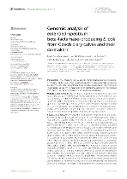| dc.contributor.author | Masarikova, Martina | |
| dc.contributor.author | Papouskova, Aneta | |
| dc.contributor.author | Sukkar, Iva | |
| dc.contributor.author | Laušová, Jarmila | |
| dc.contributor.author | Cejkova, Darina | |
| dc.contributor.author | Cizek, Alois | |
| dc.date.accessioned | 2025-05-02T08:41:03Z | |
| dc.date.available | 2025-05-02T08:41:03Z | |
| dc.date.issued | 2025 | |
| dc.identifier.uri | https://hdl.handle.net/20.500.14178/3085 | |
| dc.description.abstract | INTRODUCTION: The increasing prevalence of antimicrobial resistance in livestock, particularly the dissemination of extended-spectrum beta-lactamase-producing Escherichia coli, poses a significant zoonotic and public health risk. This study investigates the genomic characteristics of cefotaxime-resistant E. coli isolates from dairy calves across 23 Czech farms and their caretakers. MATERIALS AND METHODS: Bacteriological cultivation on McConkey agar with cefotaxime was used for their isolation, susceptibility to selected antibiotics was determined by disc diffusion method, production of extended-spectrum beta-lactamases (ESBL) was demonstrated by double disc synergy test. The PCR was applied to confirm the presence of selected genes encoding resistance to some beta-lactams and genes encoding resistance to quinolones carried on plasmids. Using whole-genome sequencing, we evaluated resistance genotypes, sequence types, serotypes, plasmid replicons, and virulence genes. RESULTS AND DISCUSSION: Among 266 rectal samples obtained from the calves, 128 (48%) harbored cefotaxime-resistant E. coli. Whole-genome analysis revealed bla(CTX-M) genes in 91% (116/128) of isolates, with bla (CTX-M-14) (44%) and bla (CTX-M-1) (34%) being the dominant variants. Other beta-lactamase gene bla(TEM-1b) was found in 40% (51/128) of isolates. Notably, no cephamycin resistance genes have been identified. The plasmid-mediated quinolone resistance (PMQR) gene qnrS1 was present at 21% (27/128) of isolates. The colistin resistance gene mcr-1 was found in a single ST2325 isolate. Sequence typing revealed significant clonal diversity, with 21 different STs detected among 68 sequenced isolates. ST10 was the most prevalent (27%), followed by ST69 (12%), ST29 (7%) and others. The phylogenetic distribution showed a predominance of commensal groups A (54%) and B1 (21%). The most common serotypes included O101:H9 (21%), O15:H18 (12%), H12, and O70:H11 (7%). Analysis of plasmid content revealed a complex distribution of 18 distinct plasmid replicon types, especially IncF, followed by Col-type and IncI1-type plasmids. Cross-species transmission was indicated by the detection of clonal strains shared between calves and caretakers, notably ST10-O101:H9 and ST34-O68:H30. The prevalence of high-risk clones and the presence of mobile resistance elements underscore the urgent need for stringent monitoring, antimicrobial stewardship, and improved biosecurity measures in livestock environments like increased caution and personal hygiene of animal handlers to mitigate the spread of resistant E. coli between animals and humans. | en |
| dc.language.iso | en | |
| dc.relation.url | https://doi.org/10.3389/fvets.2025.1552297 | |
| dc.rights | Creative Commons Uveďte původ 4.0 International | cs |
| dc.rights | Creative Commons Attribution 4.0 International | en |
| dc.title | Genomic analysis of extended-spectrum beta-lactamase-producing E. coli from Czech diary calves and their caretakers | en |
| dcterms.accessRights | openAccess | |
| dcterms.license | https://creativecommons.org/licenses/by/4.0/legalcode | |
| dc.date.updated | 2025-05-02T08:41:02Z | |
| dc.subject.keyword | ESBL | en |
| dc.subject.keyword | Escherichia coli | en |
| dc.subject.keyword | antimicrobial resistance | en |
| dc.subject.keyword | dairy cattle | en |
| dc.subject.keyword | whole-genome sequencing | en |
| dc.subject.keyword | zoonotic transmission | en |
| dc.identifier.eissn | 2297-1769 | |
| dc.relation.fundingReference | info:eu-repo/grantAgreement/MSM//LX22NPO5103 | |
| dc.date.embargoStartDate | 2025-05-02 | |
| dc.type.obd | 73 | |
| dc.type.version | info:eu-repo/semantics/acceptedVersion | |
| dc.identifier.doi | 10.3389/fvets.2025.1552297 | |
| dc.identifier.utWos | 001451875000001 | |
| dc.identifier.eidScopus | 2-s2.0-105001335346 | |
| dc.identifier.obd | 664208 | |
| dc.identifier.pubmed | 40144518 | |
| dc.subject.rivPrimary | 30000::30300::30303 | |
| dcterms.isPartOf.name | Frontiers in Veterinary Science | |
| dcterms.isPartOf.issn | 2297-1769 | |
| dcterms.isPartOf.journalYear | 2025 | |
| dcterms.isPartOf.journalVolume | 12 | |
| dcterms.isPartOf.journalIssue | March | |
| uk.faculty.primaryId | 111 | |
| uk.faculty.primaryName | Lékařská fakulta v Plzni | cs |
| uk.faculty.primaryName | Faculty of Medicine in Pilsen | en |
| uk.department.primaryId | 100012968318 | |
| uk.department.primaryName | Biomedicínské centrum | cs |
| uk.department.primaryName | Biomedical Center | en |
| uk.department.secondaryId | 1359 | |
| uk.department.secondaryName | Ústav mikrobiologie | cs |
| uk.department.secondaryName | Department of Microbiology | en |
| dc.type.obdHierarchyCs | ČLÁNEK V ČASOPISU::článek v časopisu::původní článek | cs |
| dc.type.obdHierarchyEn | JOURNAL ARTICLE::journal article::original article | en |
| dc.type.obdHierarchyCode | 73::152::206 | en |
| uk.displayTitle | Genomic analysis of extended-spectrum beta-lactamase-producing E. coli from Czech diary calves and their caretakers | en |

